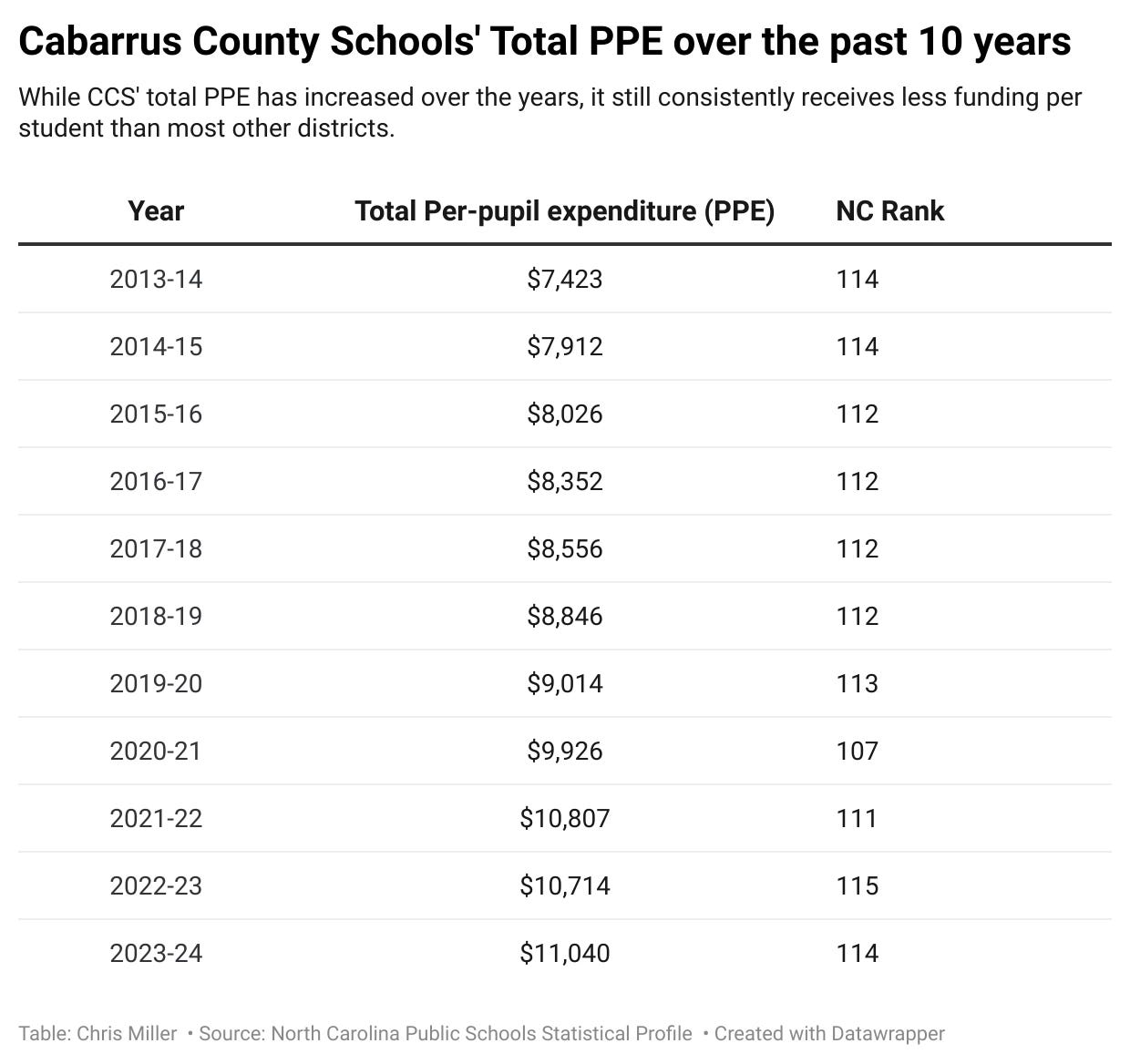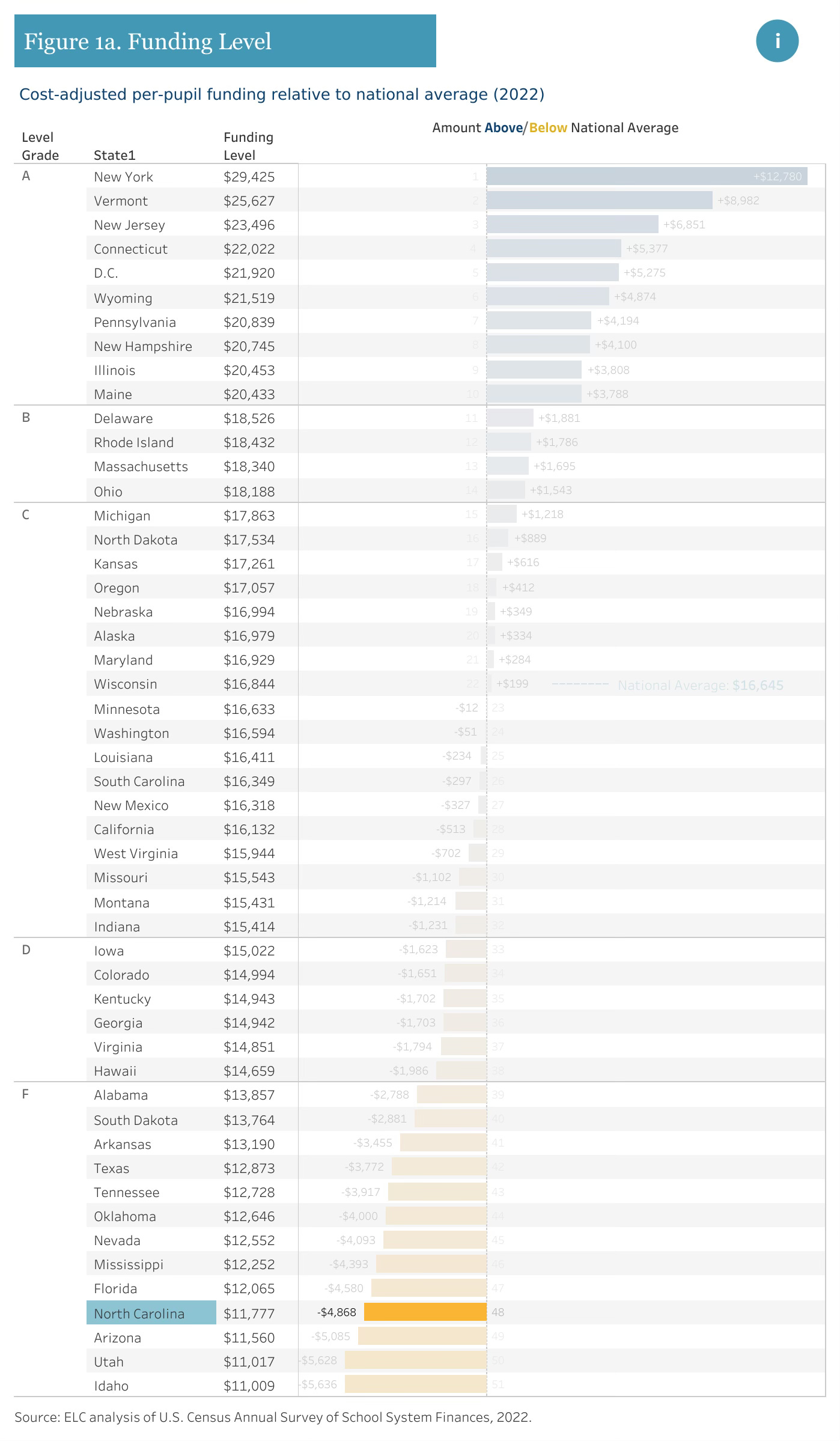Cabarrus County Schools accomplishes a lot with not enough funding
CCS in 2023-24 ranked 114th out of 115 NC school districts in total per student funding, despite being located in one of the wealthier counties in the state
Cabarrus County Schools is one of the more affluent school districts in the state, and one that often outpaces most other districts when it comes to student test scores.
And yet…CCS, which has some 35,000 students, arguably does more with less compared with most other districts across North Carolina. The district in 2023-24, which is the most current year to which state data is available, received a paltry $11,040 in per-pupil expenditure (PPE), which includes child nutrition and is defined as “the average amount of money spent to educate a child in our public schools, including local, state, and federal funding.”
The $11,040 in per-pupil funding ranked CCS 114th in the state out of 115 districts. Only Davidson County Schools ($10,877) received less funding.
As bad as that is, the district has been worse: In 2022-23, when CCS received $10,714 in total PPE, it ranked 115th, or dead last. In fact, over the previous decade, CCS has ranked no better than 107th.
The total PPE funding combines federal, state and local allocations. While CCS received $2,689 per student in local funding, which ranked 53rd across the state, the district really struggled with state and federal funding.
CCS received $7,238 per student in state funding, which ranked 112th out of 115 school districts, and received $1,112 in federal funding, which ranked 110th.
The topic was briefly addressed during last week’s county commissioner meeting, as several principals spoke about the need for more public school funding.
“We have teachers who are in year 16 to year 30, who make less than beginning firefighters who equally deserve right pay,” said Dr. Tim Taylor, principal at Hickory Ridge Middle School. He noted that while Cabarrus is one of the wealthier counties in the state, “we are second to last in local funding for schools.”
The district’s Chief Financial Officer Phillip Penn told The Cabarrus Compass that “Local funding really hasn’t kept pace with the growth that the district has experienced over the last several years.”
The growth includes Exceptional Children, as this population has increased by more than 700 students in the last four years, Penn said. The district received an estimated $9.8 million in local funds for EC services this year, a notable increase from $4.9 million in 2023-24.
The district, which unveiled its proposed $342 million budget for 2025-26 a few weeks ago, has requested a 12.7 percent increase in continuation funding from the county. It is asking for roughly $102 million in local funding, up from the $90 million which was appropriated in 2024-25.
CCS has also dealt with “rather substantial deficits” over the past two fiscal years, Penn said. The current deficit is estimated to be $6.8 million, down from $13 million in January.
Another component of the problem is simply that North Carolina struggles to adequately fund its school districts. North Carolina, in 2022, ranked 48th out of 50 states and the District of Columbia in education funding, spending $11,777 in state and local revenue per public school student, according to the latest edition of the annual “Making the Grade" report by the nonprofit Education Law Center.
Cabarrus is designated as a Tier 3 county, meaning it is one of the least distressed (and, conversely, most economically prosperous) counties in North Carolina; by contrast, many of the school districts that received the most PPE, including Hyde County Schools (ranked 1st in PPE funding with $28,611), Tyrrell County Schools (2nd), Weldon City Schools (3rd) and Halifax County Schools (4th), are located in some of the most economically distressed, or Tier 1, counties.
Cabarrus, according to the 2025 County Development Tier Rankings, is ranked 89th in the state in economic distress. Put another way: That means only 11 other counties are in a better economic position than Cabarrus.
But even among the top 10 largest counties in the state, for which Cabarrus is projected to be No. 10 as of this summer, according to data from the Office of State Budget and Management, CCS still receives less funding per student than those other districts.
Durham Public Schools is located in a county (Durham) that is both larger (around 344,000 people) and more economically prosperous (ranked 93rd in economic distress) than Cabarrus. Yet DPS received $16,054 in per student funding in 2023-24, or roughly $5,000 more than CCS.
Despite its funding struggles, CCS continues to excel academically, as 61.6 percent of CCS students were proficient on state tests for the 2023-24 school year, well above the state average and higher than most other large school districts, while 42 percent of CCS schools (18 in total) received A or B grades.
Additionally, 81 percent of CCS schools either met or exceeded expected growth, which exceeded the state average of 73 percent of schools meeting or exceeding expected growth.
But seemingly small funding gaps between CCS and some of its neighboring school districts can make a huge difference.
Union County Schools, for example, received $11,208 in total PPE in 2023-24, which was not much better than CCS. But CCS received $307 less in local funding per student compared with Union County Schools ($2,689 vs. $2,996).
That $307 difference, when multiplied by Cabarrus’ roughly 35,000 students, equates to roughly $10.7 million in local funding that CCS never received.
CCS’ neighbor to the north, Rowan-Salisbury Schools, received about $3,500 more in total PPE, with $14,556.
As part of the district’s 2025-26 proposed budget, every dollar matters.
Which only magnifies the struggles CCS has consistently faced in receiving adequate per student funding.
“We’re continuing to find ways to be more efficient with the funds we do receive,” Penn, CCS’ Chief Financial Officer, said, “but I am concerned about the long-term fiscal sustainability of the programs we currently offer with expenses continuing to grow at a much faster rate than the revenue we receive.”







